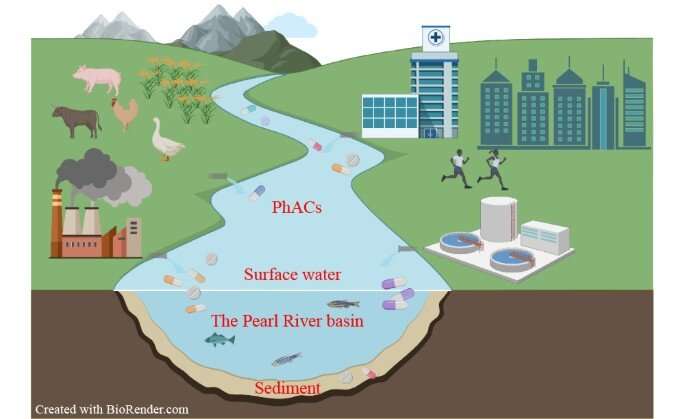This article has been reviewed according to Science X's editorial process and policies. Editors have highlighted the following attributes while ensuring the content's credibility:
fact-checked
proofread
Analyzing the fate and environmental risks of 40 pharmaceutically active compounds in the Pearl River basin

Pharmaceutically active compounds (PhACs) have attracted massive attention due to their large quantity of consumption, continuous discharge, and ecological risk to aquatic organisms in the receiving aquatic environments.
The Pearl River basin serves as an important source of drinking water for many cities in southern China. Prof. Bin Yang from the South China Normal University and their team members have worked jointly and comprehensively investigated the occurrence, fate, and environmental risk of 40 PhACs from surface waters and sediments in the Beijiang River, Xijiang River, and Maozhou River of the Pearl River basin, South China. Major classes of PhACs in this study included NSAIDs, antidepressants, anxiolytics, and antihypertension drugs. In addition, the seasonal and temporal variations in the concentrations of these PhACs among and between different rivers, along with the environmental risk were evaluated.
Their analysis is published in the journal Frontiers of Environmental Science & Engineering on April 15, 2023.
Pharmaceutically active compounds (PhACs) are widely used in humans and veterinaries to prevent, diagnose, and treat diseases. Major groups of PhACs include nonsteroidal anti-inflammatory drugs (NSAIDs), antidepressants, anxiolytics, and hypertension medicines. Most of these drugs have been regarded as emerging organic contaminants in aquatic ecosystems.
PhACs have been frequently detected in surface waters throughout the world at concentrations range of ng/L to μg/L over the past decades. The primary sources of PhACs to aquatic environments are effluents from the wastewater treatment plants (WWTPs), wastewaters from livestock and poultry industries, and sewage wastewater containing optionally disposal of expired or unused drugs.
Among the PhACs, NSAIDs are one of the most frequently used pharmaceuticals globally, and listed among the top 10 persistent pollutants. Widely detected NSAIDs in aquatic environments include ibuprofen, diclofenac, naproxen, ketoprofen, and salicylic acid. Meanwhile, psychotropic pharmaceuticals (PPhs) are widely consumed in the developed countries. Antidepressants and anxiolytics are the most widely detected PPhs in aquatic environments. Numerous studies have shown that many PhACs are toxic to aquatic organisms. Therefore, the environmental risk of PhACs cannot be simply ignored.
The Pearl River basin serves as an important source of drinking water for many cities in southern China. Previous research on the pollution of PhACs in the Pearl River basin has been conducted with one or two sampling campaigns along one main stream with recognized sources of PhACs contamination. This approach could not provide a complete understanding on variations in the frequency of occurrence and the environmental risk of PhACs. Moreover, data on PhACs for multiple rivers in the Pearl River basin by one sampling campaign in each of two seasons in a year are of relatively paucity. The work of Professor Bin Yang's team fills this gap.
In this study, the research team found the average concentrations of detected PhACs in surface waters and sediments ranged from 0.17 to 19.1 ng/L and 0.10 to 10.4 ng/g, respectively. Meanwhile, PhACs concentration in surface waters and sediments varied greatly among and within the Beijiang River, Xijiang River, and Maozhou River. The largest annual flux of PhACs of the Xijiang River and Beijiang River was more than 11,000 kg per annum, whereas only 25.7 kg/a in the Maozhou River.
In addition, the estimated emissions of PhACs in the Beijiang River, Xijiang River, and Maozhou River ranged respectively from 0.28 to 4.22 kg/a, 0.12 to 6.72 kg/a, and 6.66 to 91.0 kg/a, and the backestimated usage varied with a range from 12.0 to 293 kg/a, 6.79 to 944 kg/a, 368 to 17 459 kg/a. Moreover, the emissions of PhACs showed a close relationship with the gross domestic product (GDP) of each city along the Pearl River. The environmental risk assessment suggested that diazepam and ibuprofen had a moderate risk in this region.
This study has revealed that PhACs are ubiquitous in the surface waters and sediments of the three major rivers of the Pearl River basin. The concentrations of commonly detected PhACs are comparable to those detected in many other river basins in China, and lower than in other countries. Meanwhile, there is a distinctive spatial and seasonal variation in PhACs occurrence profiles within and among the three river basins. This study can provide important data on the fate and environmental assessment of the PhACs in the Pearl River basin. It is pointed out that a multiple-year monitoring the pollution of PhACs is necessary for a complete understanding of the risk of PhACs in the Pearl River basin.
More information: Haojun Lei et al, Occurrence, spatial and seasonal variation, and environmental risk of pharmaceutically active compounds in the Pearl River basin, South China, Frontiers of Environmental Science & Engineering (2022). DOI: 10.1007/s11783-023-1646-8
Provided by Higher Education Press




















